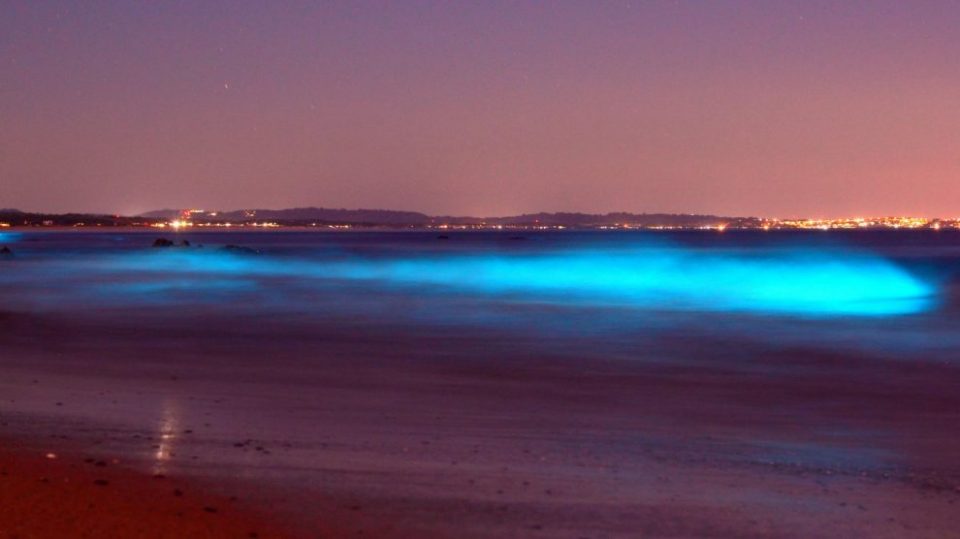countries

In some corners of the ocean, nature presents us with an unparalleled spectacle: a phenomenon in which the colors of the sea do not fade with the arrival of dusk, but rather acquire greater intensity, Transforming water into a scene of amazement and admiration. As we dive into these waters, we are surrounded by a wonderful blue glow that seems to come from a dream world.
an experience See the sea lit up at night It is simply impressive, comparable to contemplating the majestic northern lights in the northern sky, although this time we are immersed in the ocean. This unusual nocturnal phenomenon has its origins in the presence of a single-celled organism, known as Pyrodinium Bahamense, which lives on some beaches.
The “magical” beach that lights up at night
In the Piriapolis region (Uruguay), a phenomenon in the water surprised witnesses. A stunning color illuminated the water, arousing the curiosity of many tourists who took photos surrounded by the dazzling fluorescent blue. The reason for this strange phenomenon was… Noctilucas, single-celled organisms that live on these beaches in Uruguay.
Many users on social media shared pictures of the health resort, which is located 33 kilometers from Punta del Este, expressing their astonishment at the natural scene they witnessed. the Bioluminescence caused by noctilucas It made the waves light up at night, while during the day it produced a reddish color on the water.
he Head of the National Directorate of Water Resources (DINAR) of the Ministry of Livestock, Agriculture and Fisheries, Alvaro IrazukiHe explained that this photoluminescent effect is due to the presence of phytoplankton, specifically Noctiluca, which has the ability to generate bioluminescence. Although this phenomenon does not pose any danger to humans, there was some confusion about the possibility of a “red tide,” which was later dismissed.
It is important to note that although it does not pose a danger to humans, Cyanobacteria, which were also discovered on the coast of Piriapolis this summerIt can cause irritation in sensitive or allergic people. Therefore, it is recommended to take the necessary precautions when leaving the water and washing to avoid any contact with residues that may remain on the skin.
Bioluminescent beaches in Spain
Bioluminescence is a A truly wonderful natural phenomenonSome living organisms have the ability to generate light through an internal chemical reaction. Behind this magnificent light show are noctiluca bacteria, known poetically as the “spark of the sea.”
These bacteria contain A substance called luciferin, which is responsible for producing light. When a night cell senses disturbance, either by water movement or the presence of other organisms, it releases this luciferin and generates a luminous glow that turns the darkness of the ocean into a dazzling spectacle.
In this context, some beaches in Spain offer a unique spectacle, as the water is illuminated in shades of blue or green, creating the illusion of a starry night at sea. These beaches include:
Firstly, the islands of Ses and Ons, located at the mouth of the Vigo River, can only be reached by sea. During summer and Easter, different shipping companies offer daily trips from the port of Vigo to the islands of Monte Agudo and O Faro.
Likewise, on the Costa da Morte, Cape Fisterra and Corcubión form a rocky granite peninsula that offers fantastic views and the chance to witness bioluminescence.
Carnota Beach, the largest in Galicia located in La Coruña, provides an ideal environment to enjoy the luminous phenomenon, as do many of the beaches of Muxia, in the Finistere region, where up to 16 beaches allow you to enjoy bioluminescence in all its splendor.
On the other hand, Siroga Beach in Malpica, located in front of the Cisargas Islands, and Os Rias Beach in Malpica, are excellent options to experience this phenomenon in a dazzling natural setting.
In Ponticesso, Balarés Beach, at the mouth of the Cormi and Lax Rivers, stands as a paradisiacal corner on the Costa da Morte, ideal for experiencing bioluminescence in its utmost splendor.
Finally, Ribordillo Beach at Cabana de Bergantinos, surrounded by pine and eucalyptus forests, provides a tranquil and pristine environment to enjoy the light show. Likewise, O Ézaro Beach in Dumbría, located in Ezaro Bay, with its white sand and blue flag, provides the perfect place to enjoy marine bioluminescence.
In short, bioluminescence is a natural phenomenon that reminds us of the beauty and magic hidden in the most unexpected corners of our planet. It is a reminder of how amazing nature is and the importance of preserving and protecting our oceans.
The latest in curiosity





